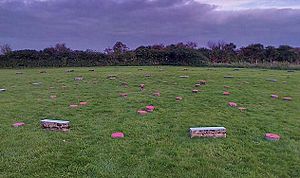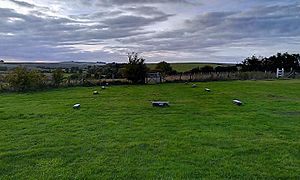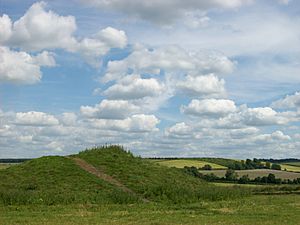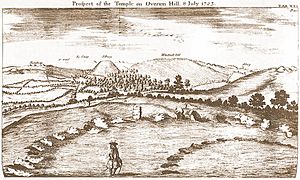The Sanctuary facts for kids
| UNESCO World Heritage Site | |
|---|---|
 |
|
| Location | Wiltshire, United Kingdom |
| Part of | Avebury Section of Stonehenge, Avebury and Associated Sites |
| Criteria | Cultural: (i), (ii), (iii) |
| Inscription | 1986 (10th Session) |
| Extensions | 2008 |
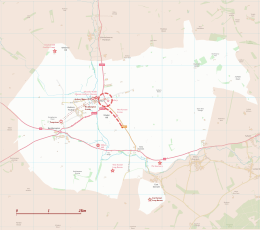
The Sanctuary was an ancient site made of stones and wooden posts. It was located near the village of Avebury in Wiltshire, England. Digs have shown where 58 stones and 62 wooden posts once stood.
This site was part of a tradition of building stone circles. These circles were built across Britain, Ireland, and Brittany. This happened during the Late Neolithic and Early Bronze Age. This period was between 3300 and 900 BCE. We don't know the exact purpose of these monuments. But experts think the stones might have stood for supernatural beings.
The Sanctuary was built on Overton Hill. It looked over older sites like West Kennet Long Barrow. It was linked to the large stone circle at Avebury by the Kennet Avenue. This was a path made of stones. The Sanctuary is also near an old path called The Ridgeway. Many Bronze Age burial mounds, called barrows, are also nearby.
In the early 1700s, an expert named William Stukeley recorded the site. But local farmers destroyed the stones in the 1720s. In 1930, Maud and Ben Cunnington dug up the site. After their work, concrete posts were put in place. These posts show where the ancient wooden posts once stood. Today, The Sanctuary is a protected site. It is part of the "Stonehenge, Avebury and Associated Sites" UNESCO World Heritage Site. Visitors can explore it for free all year.
Contents
Where to Find The Sanctuary
The Sanctuary is about 1 ½ miles southeast of Avebury. It is also 4 ½ miles west of Marlborough. It sits on the southern part of Overton Hill. From here, you can see across the River Kennet valley.
You can park your car in a special area on the A4 road. This parking spot is right next to the circle. Today, concrete markers show where the original posts were. The archaeologist Aubrey Burl said the site is "visually unexciting." He called it a "dull and stunted concrete reproduction." But other experts, Joshua Pollard and Andrew Reynolds, said its importance "should not be understated."
Understanding Ancient Circles
Between 4000 and 2000 BCE, there were big changes in England. People started building different kinds of monuments. By 3000 BCE, older structures like long mounds and enclosures were no longer built. Instead, people started making circular monuments. These included earthen henges, wooden circles, and stone circles.
Stone circles are found in most parts of Britain where there are stones. They are very common in southwest Britain and northeast Scotland. People built these circles for about 2,400 years. The main period of building was between 3000 and 1300 BCE.
These stone circles usually show little sign of people visiting them right after they were built. This suggests they were not used for everyday rituals. They might have been left as "silent and empty monuments." Some archaeologists think stone was linked to the dead. Wood, on the other hand, might have been linked to the living. Other experts believe the stones might have stood for gods or other powerful beings.
In the area of modern Wiltshire, many stone circles were built. The most famous ones are Avebury and Stonehenge. Other examples are now ruined or destroyed. Most of these circles were built in low-lying areas. There are four smaller stone circles near Avebury. These are The Sanctuary, Winterbourne Bassett Stone Circle, Clatford Stone Circle, and Falkner's Circle.
How The Sanctuary Was Built
The area where The Sanctuary was built was used by people before. Archaeologists found pieces of old pottery there. This pottery suggests people lived or worked nearby. From Overton Hill, The Sanctuary offers views of other ancient sites. These include West Kennet Long Barrow and Windmill Hill.
Digs showed that The Sanctuary had two main rings. These rings were about 40 meters across. The inner stone circle was surrounded by six rings of post holes. These holes show where wooden posts once stood.
The first building phase was around 3000 BCE. It was a ring of eight wooden posts, about 4.5 meters wide. There was also a central post, likely part of a round hut. Within 200 years, this first ring was made bigger. A second ring of eight posts was added, about 11.2 meters wide. This might have created a larger hut or an enclosed area.
Later, a third ring of 33 posts was added. This circle was 21 meters across. At the same time, an inner stone circle was built. It had 15 or 16 large sarsen stones. These stones were placed next to the middle wooden ring. This created a strong wall of stones and posts.
The final stage involved 42 sarsen stones. They formed a large outer ring, 40 meters across. These stones replaced all the wooden structures. This might have happened around the same time as the Avebury stone circle was built. This final stone circle had an entrance. This entrance led to the Kennet Avenue. The Avenue was two lines of stones. It stretched 2.5 kilometers from The Sanctuary to Avebury.
Connecting to the West Kennet Avenue
The Sanctuary is connected to the West Kennet Avenue. This is a long line of stones that goes for 2.4 kilometers. It leads all the way to the Avebury henge. The spot where the Avenue meets The Sanctuary might have been seen as its start or its end.
What Was The Sanctuary Used For?
When Maud and Ben Cunnington first dug up the site in 1930, they thought it was like a wooden version of Stonehenge. They found 162 postholes. Some had signs of double posts.
Later, experts focused on The Sanctuary's link to Avebury. They thought the two sites might have had different but related uses. The wooden posts might have held up a roof of grass or straw. This could have made a special building for rituals at Avebury. Another idea is that it was a place where bodies were kept. This would have been before or after special treatments at Avebury. The Cunningtons found old pottery and animal bones. This shows that people did use the site for some activities. More recent digs support the idea that the posts stood freely.
The site was mostly destroyed around 1723. But not before William Stukeley visited and drew it. The 1930 dig found the body of a young girl. She was buried next to an eastern stone of the inner stone circle. She was buried with a cup and animal bones. Her body was lined up with the sunrise at certain times of the year.
We are still not sure what The Sanctuary was used for. Since it was used for hundreds of years, its purpose likely changed over time.
Early Studies of The Sanctuary
The ancient site was first studied by William Stukeley. He was an expert in old things. He drew The Sanctuary on July 8, 1723. He called it the "Temple of Ertha." This name came from an old book that talked about a goddess. When Stukeley came back in 1724, he called it the "Temple on Overton Hill." He noted that local people called it "The Sanctuary."
Stukeley's drawings showed the circles as ovals. But later digs proved they were almost perfect circles. He also believed the circles were part of a giant snake shape made of stones across the land. Stukeley also wrote about how local farmers destroyed The Sanctuary.
See also
 In Spanish: El Santuario (Avebury) para niños
In Spanish: El Santuario (Avebury) para niños


